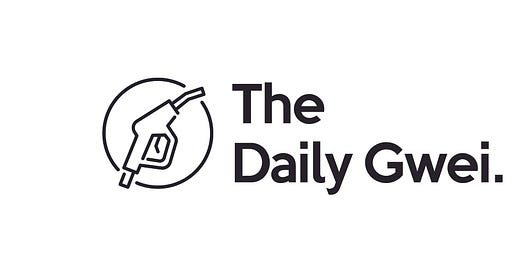Multi-Chain Speculation - The Daily Gwei #326
The crypto ecosystem is and always will be multi-chain.
I think that we’ve been asking the wrong question when it comes to talking about a “multi-chain” world. As I note below, we shouldn’t be asking if the future is multi-chain - we should be acknowledging that the crypto ecosystem has been multi-chain since the very early days and any 1 chain’s dominance diminishes over time for a variety of reasons. So if we take that into account, what are the right questions to ask?

The most obvious first question to ask is the one I have in my tweet - which platforms will have the most market-share in this multi-chain world? Right now we can say that Bitcoin and Ethereum have the most market-share out of all of crypto (probably 90%+) with a bunch of other platforms fighting each-other for the remaining 10%. Though you may be wondering how exactly I’m measuring this market-share - I would say it’s done by combining a few important metrics. For me, these are (in no particular order): market cap, active users/addresses, fees generated by the chain, TVL/volume of DeFi, general mind-share and number of developers. Each of these has a different weighting in my analysis and honestly I would say number of developers is probably the most important.
In saying that, I believe that the multi-chain ecosystem will generally follow a power law distribution where there will be a handful of massive winners (the 80%) and a long-tail of smaller ones (the 20%). Obviously I believe that Ethereum will remain the king of smart contract platforms (and I also believe it will flip Bitcoin in market cap) but I think the jury is still out on which other chains will fill in that last 20%. Will it just be Ethereum layer 2’s? Will there be some other smart contract chains that gain long-term traction? Will something like Arweave or Filecoin become massive winners with decentralized data storage? These are all questions that no one has the answers to but it does explain why you see such extreme speculation happening across the various “Ethereum killer” chains - people are just placing bets that one or more of these chains will be able to either take Ethereum’s crown or be able to slide into the remaining 20% of the power law.
On that note, I don’t blame people for speculating on these things because being the top smart contract platform is a $100 trillion+ opportunity - it’s essentially the same size opportunity as the internet. Though even if a chain/platform only captures just 2% of that opportunity it’s still worth $2 trillion - now you can probably see why there’s such intense speculation on so-called “Ethereum killers”. Of course, it’s not just the non-Ethereum chains that are vying to be part of the power law, it’s also the Ethereum-secured chains like layer 2’s that fit into this category (and again, you can see why there’s a lot of speculation here).
So let’s all just embrace this multi-chain ecosystem we find ourselves in because we’re still basically at the starting line. Over the coming years, we’ll find out which projects fit into the 80% category, which fit into the 20% one and, of course, which projects basically lose all relevance. It’s a brand new world out there folks - place your bets now and have fun riding what probably is the greatest wave of transformation the human race has ever seen.
Have a great day everyone,
Anthony Sassano
Enjoyed today’s piece? I send out a fresh one every week day - be sure to subscribe to receive it in your inbox!





Absolutely agree with your views on this. I do see some of the projects like Solana performing well into the future, but I don't see it replacing the Ethereum ecosystem. I see them all coexisting as alternative options.
So the winning smart contract platform is a $100 trillion opportunity. Have you revised your April ETH prediction up from $100,000 to $1,000,000 per ETH?